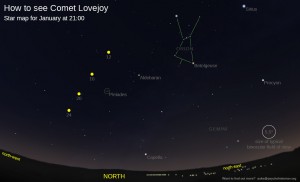by Auke Slotegraaf
Astronomers worldwide are excited about Comet Lovejoy, a new comet that is visible at the moment after sunset. The comet’s scientific name is Comet C/2014 Q2 (Lovejoy) and is named after Terry Lovejoy, the Australian astronomer and comet-hunter who discovered it. Terry found it on the morning of August 17, 2014, and this is his 5th comet discovery! He is clearly a morning person :-)
Such is the excitement surrounding this comet that local astrophotographer Dieter Willasch won international recognition for his recent photograph of Comet Lovejoy, taken from Somerset West.
Comets are small icy/rocky bodies, about 20 km from side to side, that move around the Sun. We know of about 4 000 comets in our solar system, and every year about 12 new ones are discovered. Because comets are ancient bits left over from the formation of our Sun and the solar system, they are important to study as they give clues to the origin of our planet and maybe even of life on Earth. For most of its life, a comet is far away from the Sun, in the deep cold depths of our solar system. Eventually, however, a comet’s path brings it close to the Sun, and we get a chance to see it clearly.
During the course of any given year, about 17 comets approach the Sun before being flung back into deep space. Almost all comets are very faint and require telescopes to be seen. Once every couple of years, however, a comet bright enough to be seen in binoculars (or with the naked eye alone) makes an appearance. 2015 is such a year! (And the year has only just started!) For the next 10 days or so, Comet Lovejoy can be seen after sunset in the north-west.
Comet Lovejoy is now rapidly approaching its close encounter with the Sun, and time is fleeting! If you miss it, you will have to wait 8 000 years to see it again!
To see the comet, use the star map below. One map has labels, the other doesn’t. Use whichever one you are most comfortable with.
The star map is drawn to be correct for 21:00. If you look at a later time, the stars will appear lower down.
The comet is shown as a big yellow dot, for Monday 12th, Friday 16th, Tuesday 20th and Saturday 24th January.
Start by going outdoors a little before 21:00 and find a spot that is free from light pollution (street lights shining in your eye, etc.). Give your eyes a few minutes to adapt to the darkness. Stand facing north (in other words, with sunset direction on your left). Look up and a bit to your right for the three bright stars in a row that make up Orion’s Belt. Then look down and to the left for the bright star Aldebaran. Further down and left is the beautiful star cluster called the Pleiades, or Seven Sisters. Now judge where the yellow blob should be in the sky, and take a close look. Scan the area carefully – and voila! you will have found the comet.
If you can’t see it with your naked eye, use a pair of binoculars. Judge where the yellow dot is and scan around until you find a circular patch of white light, about half the size of the Moon, with a bright spot in the centre. That bright spot is the nucleus of the comet, which is about 75 million km away from us. The circular patch is known as the coma, and it is a 10,000 km wide halo of glowing dust surrounding the coma, evaporated off from the usually totally frozen nucleus. With a telescope, you may get a glimpse of the comet’s tail, which is a whispy affair millions of kilometers long.
While you’re there, take a look at the Pleiades star cluster, a family of stars born together and one of the nearest star clusters to Earth. How many Pleiads can you see with the naked eye alone? And with binoculars?


